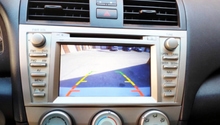Toyota Camry: Crash Test and Safety Ratings
Crash test and safety ratings reveal important information you'll want to know before making your next Camry purchase.
This article applies to the Toyota Camry (1997-2011).
The Toyota Camry is a moderately priced sedan with the safety features you would expect in a vehicle of its class. Rated highly across a number of test crash scenarios, the Toyota Camry has performed consistently with only minor deviations from one generation to the next. Let's take a closer look at each generation of this highly popular sedan to determine which model years provide the greatest measure of safety to you and your passengers.
Crash Test and Safety Ratings
Fourth Generation Camry Vehicles (1997-2001)
Fourth generation Camry vehicles are some of the safest vehicles on the road, particularly when it comes to severe crashes.
Test |
Poor |
Acceptable |
Good |
|---|---|---|---|
| Overall Evaluation | |||
| Structure and Safety Cage | |||
| Injury Measures: Head/Neck | |||
| Chest | |||
| Leg/Foot, Left | |||
| Leg/Foot, Right | |||
| Restraints and Dummy Kinematics |
According to tests carried out by the Insurance Institute for Highway Safety (IIHS), the 1997-2001 Camry demonstrated a low risk of injury to occupants' head, neck or legs (right and left) when involved in a front crash test. Head lacerations and other injuries to the head could occur, however, due to a possible impact with the B-pillar, which is a molding used to hold your car's windows in place.
Test |
Rating |
|---|---|
| Front, Driver's | |
| Front, Passenger's | |
| Overall Rollover Rating | |
| Side Barrier Rating, Driver | |
| Side Barrier Rating, Rear Passenger Seat |
The National Highway Traffic Safety Association (NHTSA) conducted frontal crash tests on the 1997 Toyota Camry and awarded it four stars for both driver and front passenger safety. Scoring an equally high rating, the 1998-2001 Camry, which underwent a number of significant modifications for improved safety and performance, garnered four stars as well.
Featured Video: 1998-2001 Toyota Camry Crash Test
Fifth Generation Camry Vehicles (2002-2006)
Fifth generation Camry vehicles received the same IIHS safety ratings as fourth generation models. Additional tests across a range of categories also reveal equally high ratings:
Side Without Air Bags (IIHS)
Test |
Poor |
Marginal |
Acceptable |
Good |
|---|---|---|---|---|
| Overall Evaluation | ||||
| Structure and Safety Cage | ||||
| Driver Injury Measures: Head/Neck | ||||
| Torso | ||||
| Pelvis/Leg | ||||
| Head Protection | ||||
| Rear Passenger Injury Measures: Head/Neck | ||||
| Torso | ||||
| Pelvis/Leg | ||||
| Head Protection |
The redesigned fifth generation Camry is a safe vehicle; however, there are some safety concerns, nonetheless, when it comes to driver and passenger head and torso injuries. Head injuries could occur as an occupant is pushed against a window or pillar inside the car during a collision. Safety belts should be word at all times to lessen risk of these and other types of injuries.
Side with Air Bags (IIHS)
With air bags, the fifth generation Camry receives a "good" rating for all test details (as listed in the chart above), including all rear passenger injury measures. Only two test details (structure and safety cage as well as pelvis and leg, driver) received an "acceptable" rating.
NHTSA Ratings
NHTSA ratings remained high with the fifth generation Camry receiving high marks for front driver and passenger safety (four and five stars, respectively), overall rollover rating (five stars), as well as driver and passenger side barrier protection ( three stars).

Sixth Generation Camry Vehicles (2007-2011)
IIHS frontal offset crash test ratings for the sixth generation Camry were strong across the board, with a "marginal" rating for overall rear protection. Otherwise, the 2007-2011 Camry garnered a "good" rating driver and passenger protection across categories, including head and neck, legs and chest.
Test |
Poor |
Marginal |
Acceptable |
Good |
|---|---|---|---|---|
| Moderate overlap front | ||||
| Side | ||||
| Roof strength | ||||
| Head restraints | ||||
| Seats |
NHTSA
The sixth generation Camry performed well for NHTSA frontal crash tests, receiving a "good" rating for both front driver and passenger side protection.

Common Questions
Are anti-lock brakes standard in all 1997 Camry models?
Anti-lock brakes make it possible for your car to stop on a slippery surface, thereby preventing a possible accident. While not standard on base models, anti-lock brakes are standard in all other models and are reviewed favorably among Camry owners and crash test agencies.
Which safety features are standard on 5th generation Camry models?
Side air bags and daytime running lights are standard on all 5th generation models. Electronic stability control is optional. Anti-lock brakes are standard on 2005-2006 models, but optional on 2002-2004 models.
Featured Video: 1998-2011 Toyota Camry NHTSA Crash Test
Related Sites
- Camry Review - Samarins.com
- Camry Safety Rating - Cars.com
- Camry 4 Dr Sedan 2004 - IIHS.org
- Camry 4 Dr Sedan 2007 - IIHS.org






